Calibrating and Validating the MFI-UF Method to Measure Particulate Fouling in Reverse Osmosis
Abstract
1. Introduction
- (i)
- To examine the MFI-UF calibration using different calibration solutions of standard particles (dextran and polystyrene).
- (ii)
- To validate the MFI-UF using natural (surface) water as a representative of the real water in RO systems.
2. MF-UF Theoretical Background
3. Materials and Methods
3.1. MFI-UF Set-Up
3.2. MFI-UF Membranes
3.3. MFI-UF Calibration Using Standard Particle Solutions
- The verification of MFI-UF linearity at both the lower and higher range of particle concentration. For RO applications, it is important that the calibration/linearity range covers the MFI-UF of RO feed water. Based on previous work (Abunada et al., 2023), the MFI-UF values of different RO feed waters measured at the same testing conditions shown in Table 2 (at 100 L/m2·h using 100 kDa membrane) were in the range of 550–1150 s/L2. However, this range may be different for other types of RO feed water.
- The reproducibility of MFI-UF linearity under the same testing conditions (i.e., at the same flux and same MFI-UF membrane MWCO).
3.4. MFI-UF Validation Using Natural Water
4. Results and Discussion
4.1. MFI-UF Calibration Using Standard Solutions
4.1.1. Dextran Particle Solution
Linearity Verification
Reproducibility
4.1.2. Polystyrene Particle Solution
Linearity Verification
Reproducibility
4.2. MFI-UF Linearity Using Natural Water (Canal Water)
5. Conclusions
Supplementary Materials
Author Contributions
Funding
Institutional Review Board Statement
Data Availability Statement
Conflicts of Interest
Nomenclature
| MFI-UF | Modified fouling index—ultrafiltration {s/L2} |
| Fouling index {1/m2} | |
| Flux {L/m2·h or m3/m2·s} | |
| Transmembrane pressure {bar or Pa} | |
| Clean membrane resistance {1/m} | |
| Feed water viscosity {N·s/m2} | |
| Filtration time {s, min, h, day, or month} | |
| Particle concentration {mg/L} | |
| Specific cake resistance {m/kg} | |
| Cake porosity {-} | |
| ρ | Particle density {kg/m3} |
| Particle diameter {m} | |
| Reference transmembrane pressure {= 2 bar or 200 kPa} | |
| Reference water viscosity at 20 °C {= 0.001002 N·s/m2} | |
| Reference MFI membrane surface area {= 0.00138 m2} |
References
- ASTM D4189-07; Standard Test Method for Silt Density Index (SDI) of Water. ASTM: West Conshohocken, PA, USA, 2014.
- ASTM D8002-15; Standard Test Method for Modified Fouling Index (MFI-0.45) of Water. ASTM: West Conshohocken, PA, USA, 2015.
- Schippers, J.C.; Verdouw, J. The modified fouling index, a method of determining the fouling characteristics of water. Desalination 1980, 32, 137–148. [Google Scholar] [CrossRef]
- Schippers, J.C.; Folmer, H.C.; Verdouw, J.; Scheerman, H.J. Reverse osmosis for treatment of surface water. Desalination 1985, 56, 109–119. [Google Scholar] [CrossRef]
- Boerlage, S.F.E.; Kennedy, M.D.; Aniye, M.P.; Abogrean, E.; Tarawneh, Z.S.; Schippers, J.C. The MFI-UF as a water quality test and monitor. J. Membr. Sci. 2003, 211, 271–289. [Google Scholar] [CrossRef]
- Boerlage, S.F.E.; Kennedy, M.D.; Aniye, M.P.; Abogrean, E.M.; Galjaard, G.; Schippers, J.C. Monitoring particulate fouling in membrane systems. Desalination 1998, 118, 131–142. [Google Scholar] [CrossRef]
- Boerlage, S.F.E.; Kennedy, M.D.; Bonne, P.A.C.; Galjaard, G.; Schippers, J.C. Prediction of flux decline in membrane systems due to particulate fouling. Desalination 1997, 113, 231–233. [Google Scholar] [CrossRef]
- Boerlage, S.F.E.; Kennedy, M.D.; Dickson, M.R.; El-Hodali, D.E.Y.; Schippers, J.C. The modified fouling index using ultrafiltration membranes (MFI-UF): Characterisation, filtration mechanisms and proposed reference membrane. J. Membr. Sci. 2002, 197, 1–21. [Google Scholar] [CrossRef]
- Boerlage, S.F.E.; Kennedy, M.; Tarawneh, Z.; De Faber, R.; Schippers, J.C. Development of the MFI-UF in constant flux filtration. Desalination 2004, 161, 103–113. [Google Scholar]
- Salinas-Rodríguez, S.G.; Amy, G.L.; Schippers, J.C.; Kennedy, M.D. The modified fouling index ultrafiltration constant flux for assessing particulate/colloidal fouling of RO systems. Desalination 2015, 365, 79–91. [Google Scholar] [CrossRef]
- Abunada, M.; Dhakal, N.; Andyar, W.Z.; Ajok, P.; Smit, H.; Ghaffour, N.; Schippers, J.C.; Kennedy, M.D. Improving MFI-UF constant flux to more accurately predict particulate fouling in RO systems: Quantifying the effect of membrane surface porosity. J. Membr. Sci. 2022, 660, 120854. [Google Scholar] [CrossRef]
- Carman, P.C. Fundamental principles of industrial filtration (A critical review of present knowledge). Trans. Instn Chem. Engrs. 1938, 16, 168–688. [Google Scholar]
- Salinas-Rodríguez, S.G.; Kennedy, M.D.; Amy, G.L.; Schippers, J.C. Flux dependency of particulate/colloidal fouling in seawater reverse osmosis systems. Desalination Water Treat. 2012, 42, 155–162. [Google Scholar]
- Salinas-Rodriguez, S.G. Particulate and Organic Matter Fouling of Seawater Reverse Osmosis Systems: Characterization, Modelling and Applications. Dissertation Thesis, Delft University of Technology, Delft, The Netherlands, 2011. [Google Scholar]
- Kutscher, H.L.; Chao, P.; Deshmukh, M.; Singh, Y.; Hu, P.; Joseph, L.B.; Reimer, D.C.; Stein, S.; Laskin, D.L.; Sinko, P.J. Threshold size for optimal passive pulmonary targeting and retention of rigid microparticles in rats. J. Control. Release 2010, 143, 31–37. [Google Scholar] [CrossRef] [PubMed]
- Abunada, M.; Dhakal, N.; Gulrez, R.; Ajok, P.; Li, Y.; Abushaban, A.; Smit, H.; Moed, D.; Ghaffour, N.; Schippers, J.C.; et al. Prediction of particulate fouling in full-scale reverse osmosis plants using the modified fouling index – ultrafiltration (MFI-UF) method. Desalination 2023, 553, 116478. [Google Scholar] [CrossRef]
- Boerlage, S.F.E.; Kennedy, M.; Aniye, M.P.; Schippers, J.C. Applications of the MFI-UF to measure and predict particulate fouling in RO systems. J. Membr. Sci. 2003, 220, 97–116. [Google Scholar] [CrossRef]

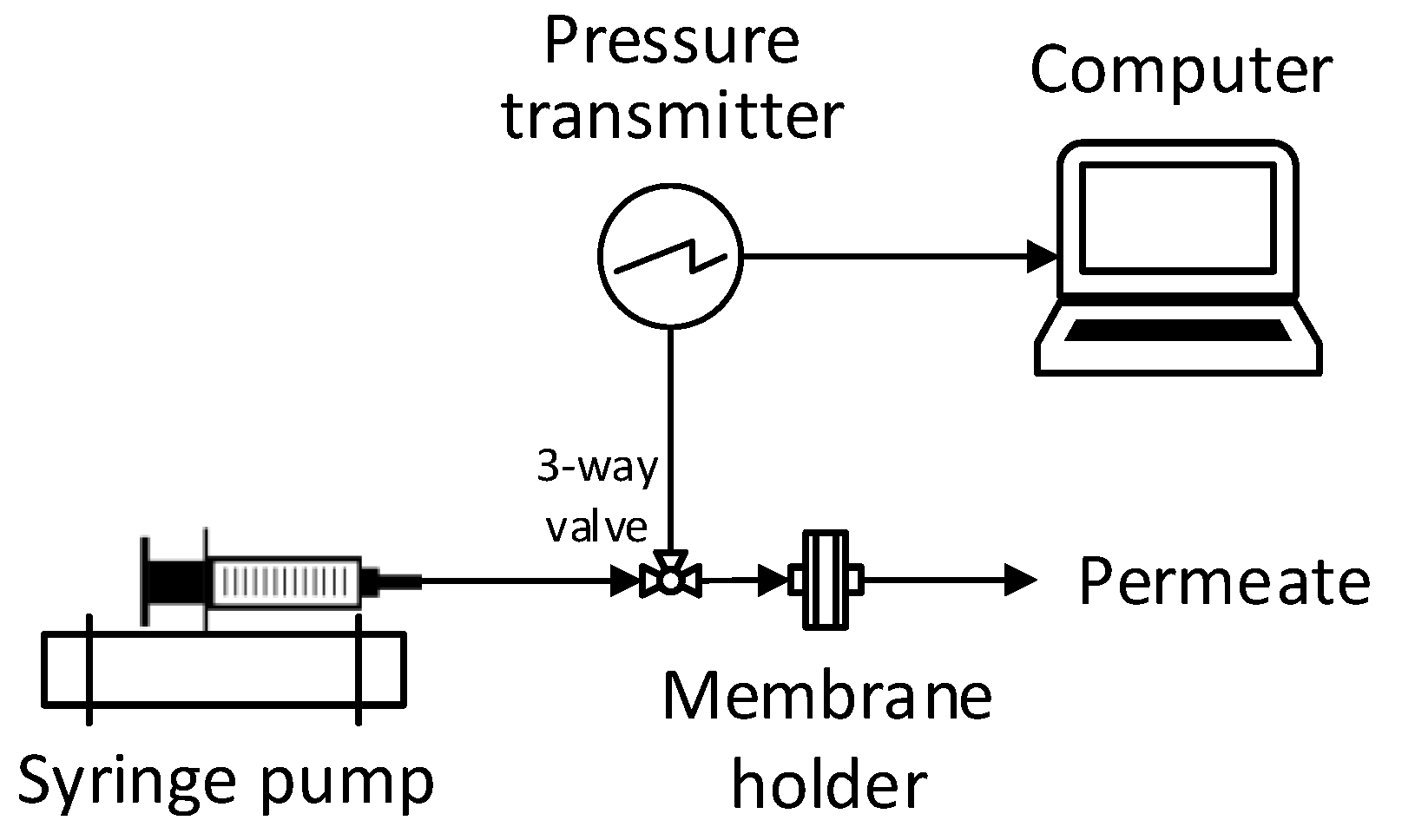
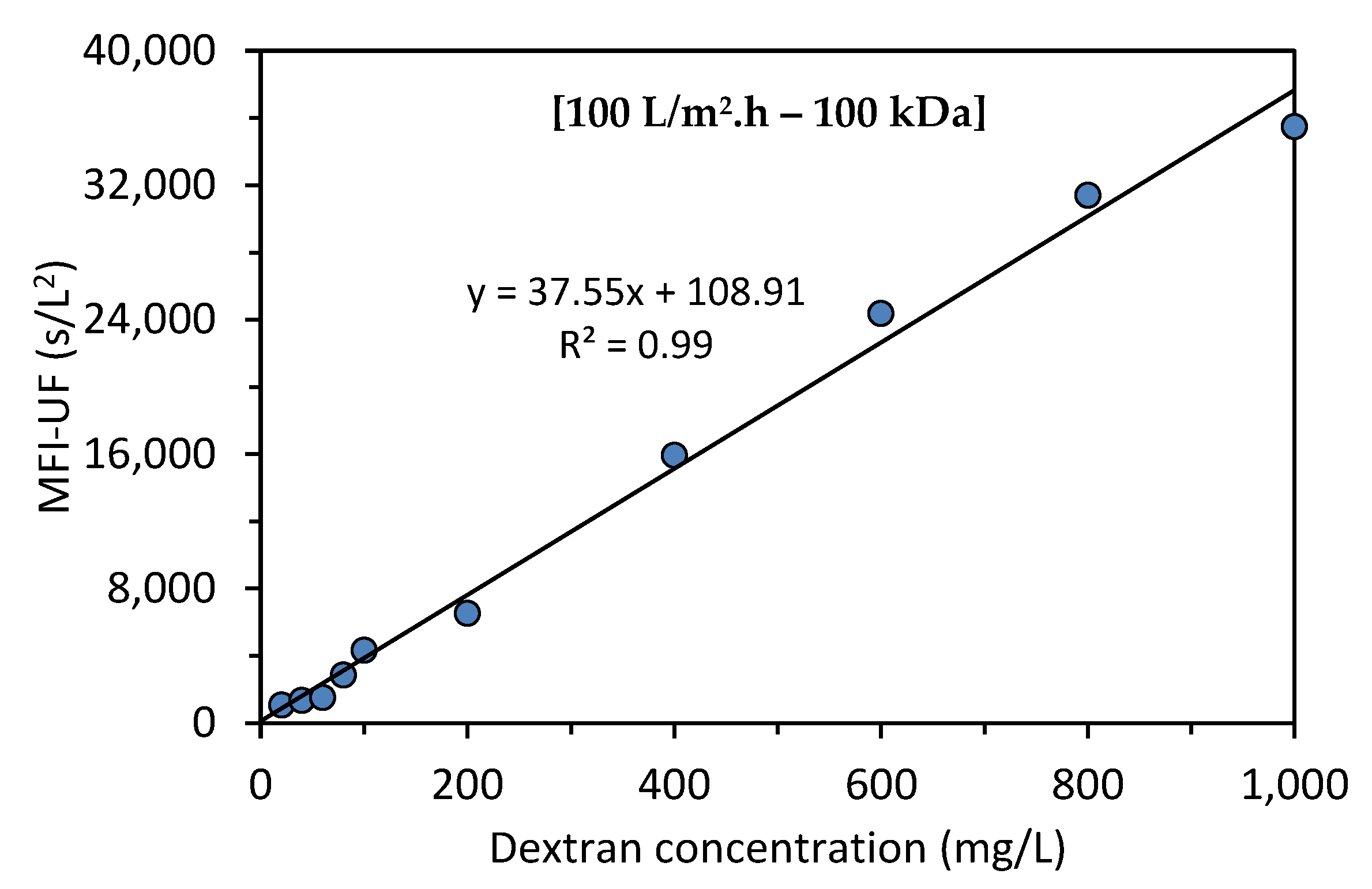
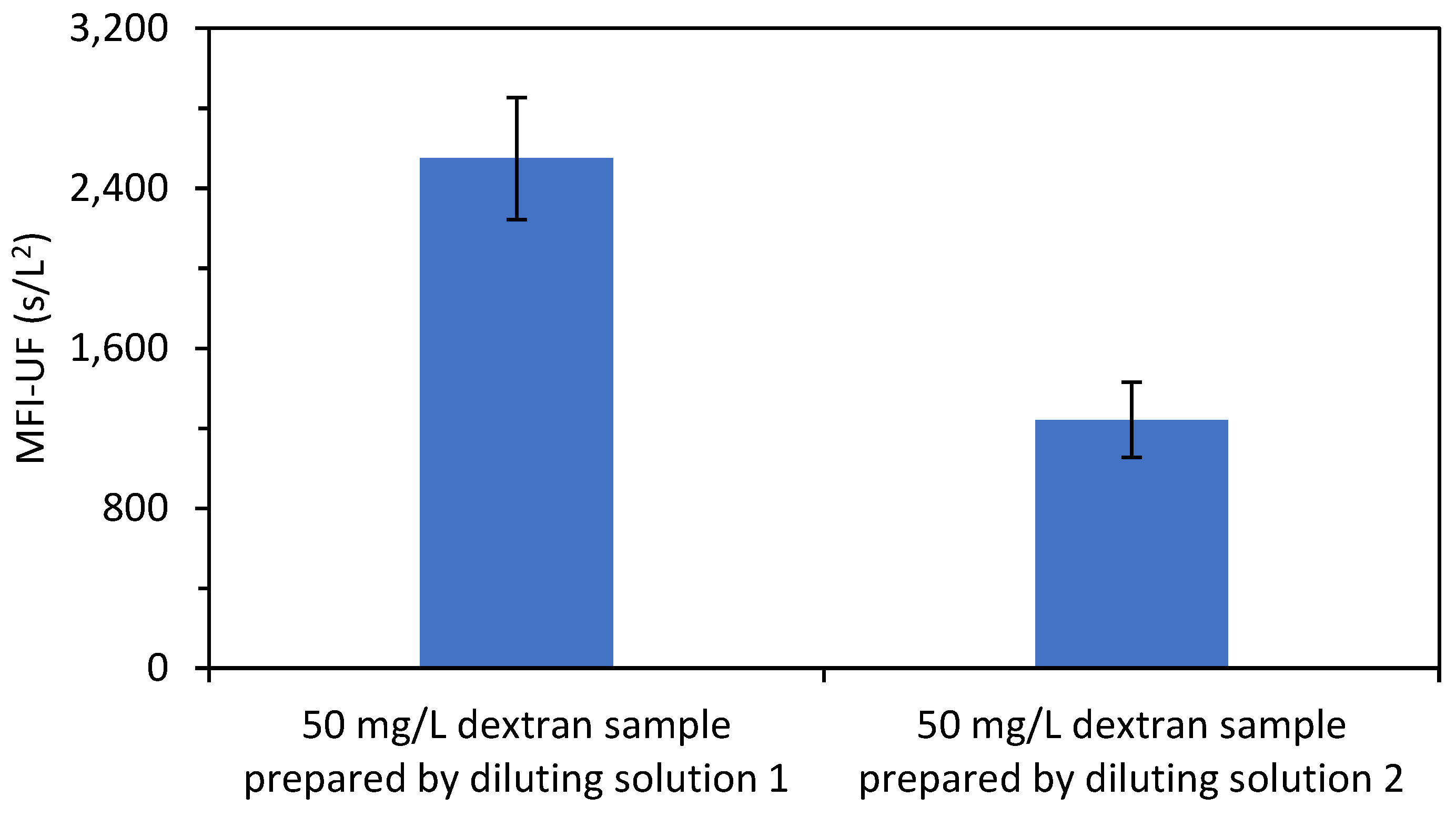
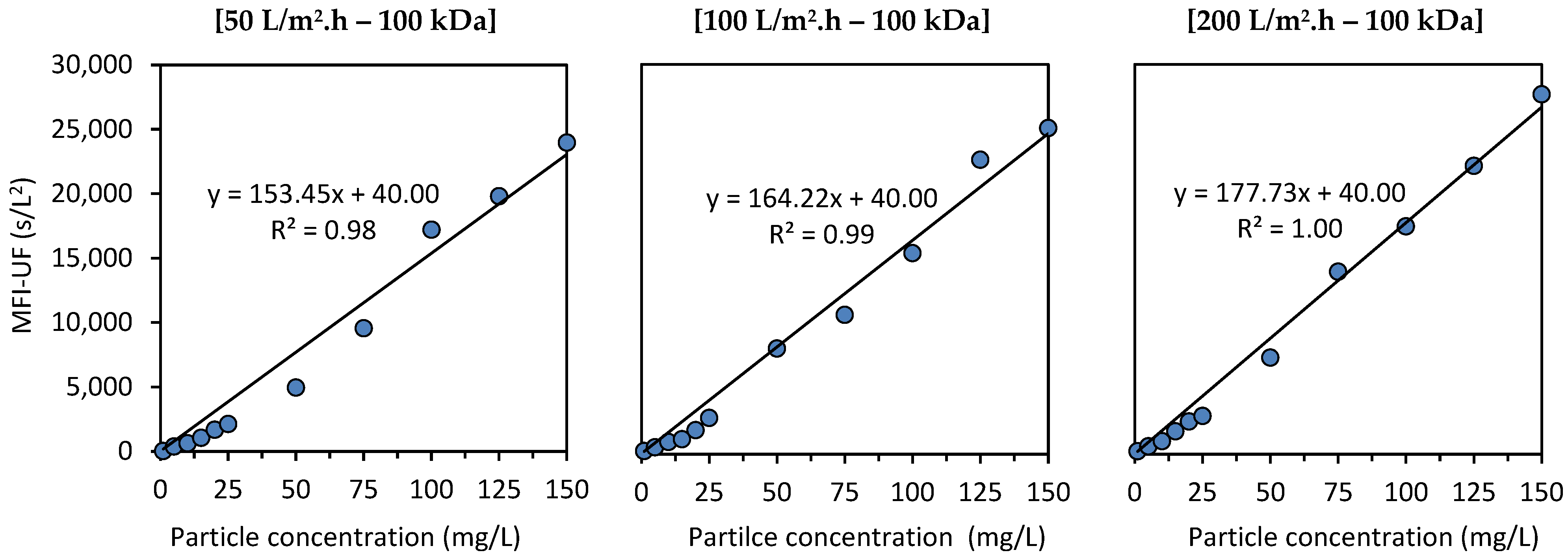

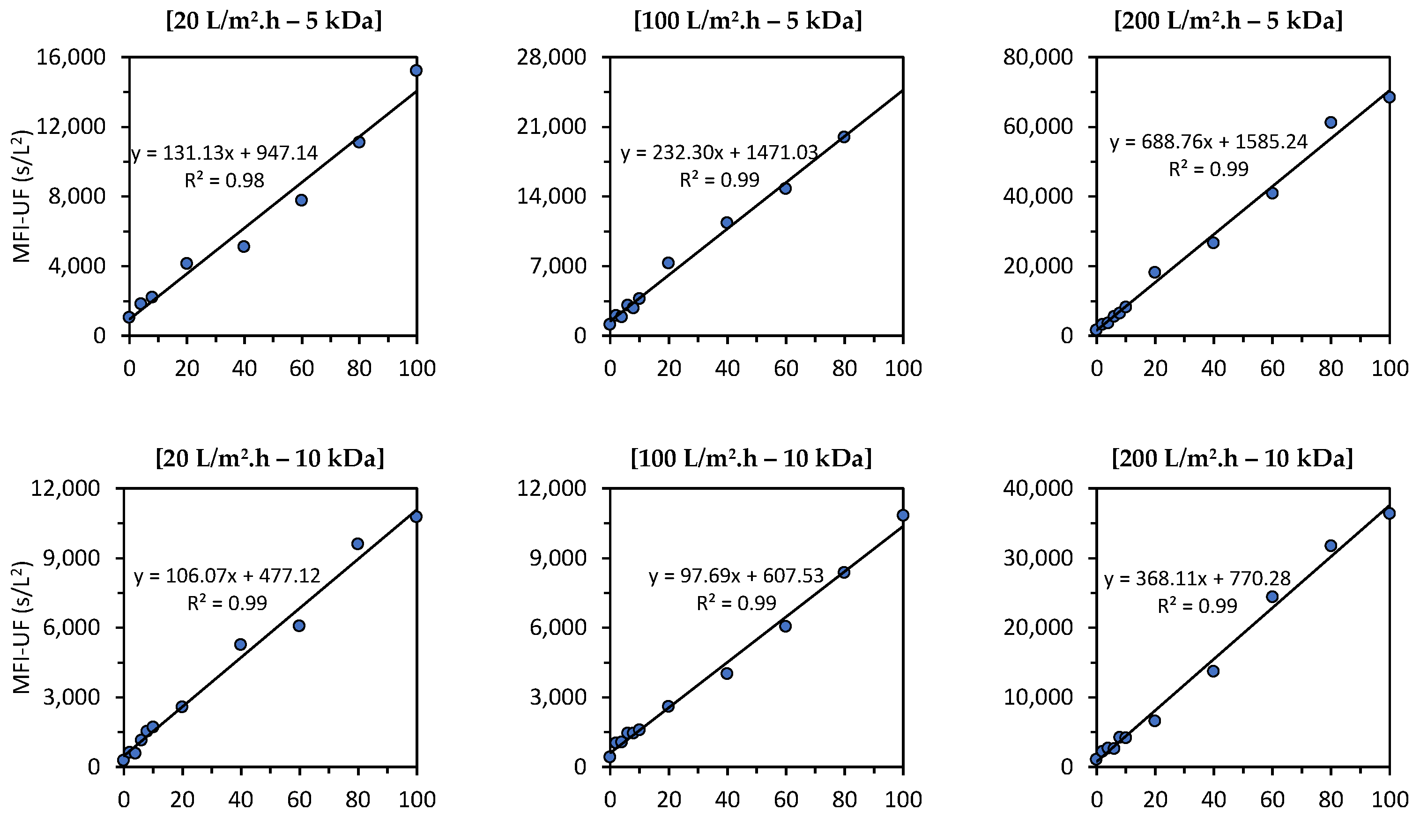

| Instrument | Model, Manufacturer | Accuracy | Reproducibility |
|---|---|---|---|
| Infusion pump | PHD ULTRATM HPSI, Harvard Apparatus | 5% < set flow | 1% |
| PHD ULTRATM standard, Harvard Apparatus | 5% < set flow | 1% | |
| Pressure transmitter | Cerabar PMC51, Endress+Hauser | ±1% | 0.5% |
| PXM409, Omega | ±1% | 0.5% |
| Standard Particles Used in Feed Solution | Concentrations | Flux | MFI-UF Membrane |
|---|---|---|---|
| Dextran (150 kDa) | Lower range: 20, 40, 60, 80, and 100 mg/LHigher range: 200, 400, 600, 800, and 1000 mg/L | 100 L/m2·h | 100 kDa |
| Polystyrene (25 nm) | Lower range: 1, 5, 10, 15, 20, and 25 mg/LHigher range: 50, 75, 100, 125, and 150 mg/L | 50, 100, and 200 L/m2·h | 100 kDa |
| Feed Solution | Concentration * | Flux | MFI-UF Membrane |
|---|---|---|---|
| Canal water (CW) | Lower range: 0, 2, 4, 6, 8, and 10% Higher range: 20, 40, 60, 80, and 100% | 20, 100, and 200 L/m2·h | 5, 10, and 100 kDa |
Disclaimer/Publisher’s Note: The statements, opinions and data contained in all publications are solely those of the individual author(s) and contributor(s) and not of MDPI and/or the editor(s). MDPI and/or the editor(s) disclaim responsibility for any injury to people or property resulting from any ideas, methods, instructions or products referred to in the content. |
© 2023 by the authors. Licensee MDPI, Basel, Switzerland. This article is an open access article distributed under the terms and conditions of the Creative Commons Attribution (CC BY) license (https://creativecommons.org/licenses/by/4.0/).
Share and Cite
Abunada, M.; Dhakal, N.; Andyar, W.Z.; Li, Y.; Ajok, P.; Ghaffour, N.; Schippers, J.C.; Kennedy, M.D. Calibrating and Validating the MFI-UF Method to Measure Particulate Fouling in Reverse Osmosis. Membranes 2023, 13, 535. https://doi.org/10.3390/membranes13050535
Abunada M, Dhakal N, Andyar WZ, Li Y, Ajok P, Ghaffour N, Schippers JC, Kennedy MD. Calibrating and Validating the MFI-UF Method to Measure Particulate Fouling in Reverse Osmosis. Membranes. 2023; 13(5):535. https://doi.org/10.3390/membranes13050535
Chicago/Turabian StyleAbunada, Mohanad, Nirajan Dhakal, William Z. Andyar, Yuke Li, Pamela Ajok, Noreddine Ghaffour, Jan C. Schippers, and Maria D. Kennedy. 2023. "Calibrating and Validating the MFI-UF Method to Measure Particulate Fouling in Reverse Osmosis" Membranes 13, no. 5: 535. https://doi.org/10.3390/membranes13050535
APA StyleAbunada, M., Dhakal, N., Andyar, W. Z., Li, Y., Ajok, P., Ghaffour, N., Schippers, J. C., & Kennedy, M. D. (2023). Calibrating and Validating the MFI-UF Method to Measure Particulate Fouling in Reverse Osmosis. Membranes, 13(5), 535. https://doi.org/10.3390/membranes13050535








